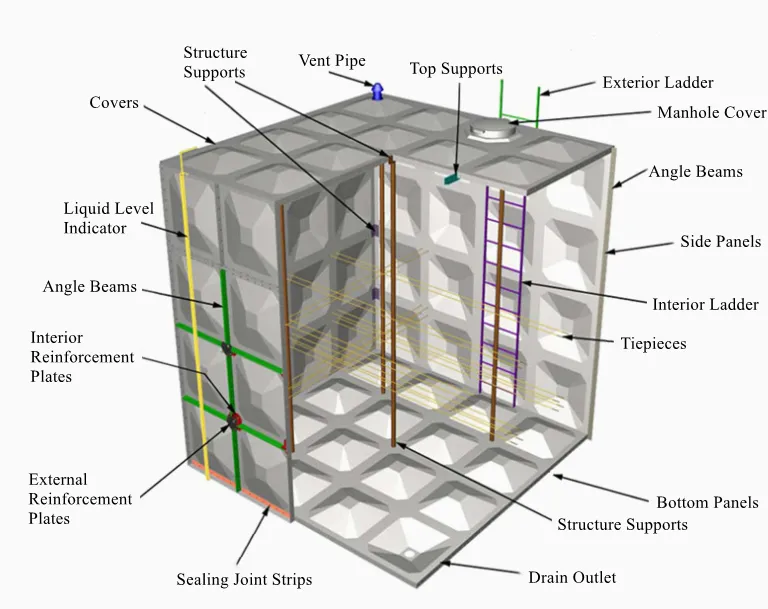loading...
- No. 9, Xingyuan South Street, Dongwaihuan Road, Zaoqiang County, Hengshui, Hebei, China
- admin@zjcomposites.com
- +86 15097380338
- Welcome to visit our website!
frp structural members
The Role of FRP Structural Members in Modern Engineering
Fiber-Reinforced Polymer (FRP) composites have gained significant attention in the field of civil and structural engineering, becoming a favored material for the design and construction of various structures. These innovative materials combine the high strength of fibers with the lightweight, corrosion-resistant properties of polymers, resulting in structural members that are not only robust but also highly versatile. In this article, we explore the characteristics, applications, and advantages of FRP structural members, as well as their impact on modern engineering practices.
Characteristics of FRP Structural Members
FRP structural members are comprised of a polymer matrix reinforced with fibers, such as glass, carbon, or aramid. This combination provides an excellent strength-to-weight ratio, making them ideal for applications where reducing weight is crucial. Additionally, FRP materials are resistant to moisture, chemicals, and UV radiation, ensuring durability in harsh environments. Their electrical insulation properties make them suitable for environments where electromagnetic interference can be a concern.
Applications in Construction
The applications for FRP structural members are vast and varied. One of the most significant uses of FRP is in the construction of bridges and elevated roadways. Traditional materials such as steel and concrete are facing increasing challenges due to corrosion and maintenance costs. FRP composites, however, can offer a longer lifespan with less need for maintenance, ultimately reducing lifecycle costs for infrastructure projects.
FRP is also gaining traction in retrofitting existing structures. Engineers use FRP sheets or laminates to strengthen beams, columns, and slabs, enhancing the load-carrying capacity of aging infrastructure without adding significant weight. This capability has become increasingly important in earthquake-prone areas, where the flexibility and strength of FRP can significantly improve the resilience of structures.
Advantages Over Traditional Materials
frp structural members

The advantages of FRP structural members extend beyond their physical properties. The lightweight nature of FRP allows for easier handling and installation, which can lead to significant savings in labor and equipment costs during construction. Additionally, since FRP does not corrode like metal or degrade like wood, it requires less maintenance over its lifespan, further reducing operational costs.
Moreover, the design flexibility offered by FRP facilitates the creation of complex shapes and forms that can be difficult or impossible to achieve with traditional materials. This architectural freedom allows engineers and architects to innovate and push the boundaries of modern design.
Environmental Considerations
In an era where sustainability is a critical consideration in engineering, FRP composites often present a more environmentally friendly alternative. The durability and longevity of FRP materials contribute to reducing the environmental impact of construction projects, as fewer resources are needed for maintenance and replacement. Additionally, developments in the recycling of FRP materials are underway, enhancing their sustainability profile.
Conclusion
As the construction industry continues to evolve, the role of FRP structural members becomes increasingly vital. Their unique properties offer numerous advantages over traditional materials, making them suitable for various applications, including bridges, retrofitting of structures, and innovative architectural designs. The shift towards lightweight, corrosion-resistant, and sustainable materials positions FRP composites as a cornerstone for the future of engineering.
In summary, FRP structural members not only meet the demands of modern construction but also pave the way for innovative solutions that enhance the durability, sustainability, and efficiency of our built environment. As research and technology progress, the integration of FRP composites in everyday applications will likely become more prevalent, enriching the field of civil and structural engineering and ultimately benefitting society as a whole.
-
The Rise of FRP Profiles: Strong, Lightweight, and Built to LastNewsJul.14,2025
-
SMC Panel Tanks: A Modern Water Storage Solution for All EnvironmentsNewsJul.14,2025
-
GRP Grating: A Modern Solution for Safe and Durable Access SystemsNewsJul.14,2025
-
Galvanized Steel Water Tanks: Durable, Reliable, and Ready for UseNewsJul.14,2025
-
FRP Mini Mesh Grating: The Safer, Smarter Flooring SolutionNewsJul.14,2025
-
Exploring FRP Vessels: Durable Solutions for Modern Fluid HandlingNewsJul.14,2025
-
GRP Structures: The Future of Lightweight, High-Performance EngineeringNewsJun.20,2025
